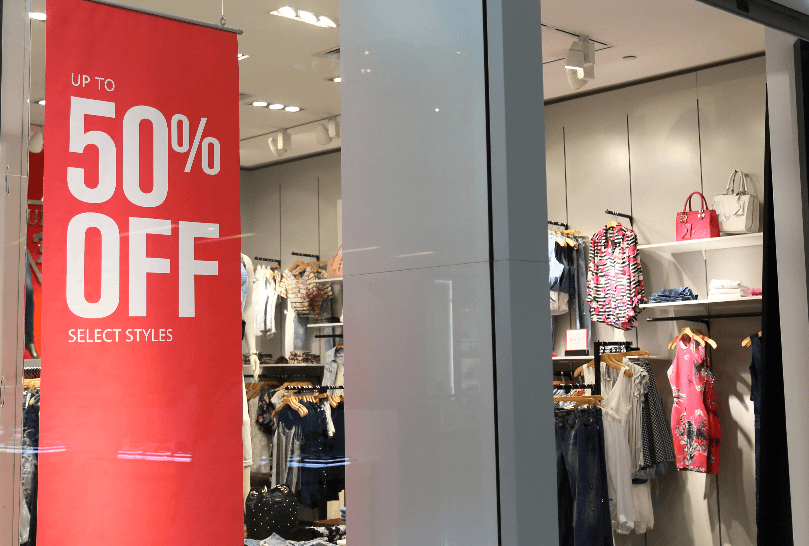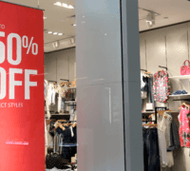Using Indoor Displays
Posted by Half Price Banners on Dec 5th 2017
The Value of Indoor Displays
Think back to the last time you were in a store during a sale: what stood out? Were you aware of the sale before going in or were you reminded of it once you got there? How long did the sale last? Did you feel like you were getting a good deal?
These questions are important because your customers will have similar memories of your sales, and doing it right is crucial to providing those customers a good feeling about your company both to tell others and to come back themselves. This article will try to help guide you make the best decisions for your indoor displays and get you thinking about the value of good impressions of atmosphere, the potential value of underutilized floor or wall space, and the immediate value of upselling.

Planning with a Purpose
Before any display goes up, there needs to be a little planning. First, focus on who the sale is for and what the value for them will be. Do you want to bring extra attention to new or different products by offering samples or discounts? Are you trying to attract new customers who will see the display from outside, or do you want to redirect current visitors to certain areas of your store?
Once you’ve determined the value incentive for the customer, you’ll need to set goals. There are more easily measured goals such as: How many additional products are you trying to sell? How many new customers are you trying to bring in? – and then there are more difficult goals to measure: Did the customer feel like they got an amazing deal? Will this sale create some referrals because this person had such a great experience?
One of the best things about indoor displays is that they serve many purposes. Once you’re aware of these benefits and what they do, that’s when you can leverage each according to your own goals.
Creating the Mood for the Sale
Because a sale is usually only for a limited time, this creates an initial sense of urgency to purchase whatever has gone on sale or the customer risks missing out on the deal. Many displays will reinforce this urgency with how they’re worded: Get it quick, Fast, Don’t Miss Out, Hurry, Sale Ends Soon. They’re usually also brightly colored to grab your attention while any messaging is usually happy and concise enough to let you understand what’s happening immediately. Don’t forget that it’s not simply a sale: it’s a shopping experience. Sometimes the difference a few standing displays can make is bigger than you might think.
Finding the Space for Displays
A common misconception during planning a sale can often be that there’s just not enough room for big displays. While this is true for certain types of three dimensional displays, it’s rare to lack enough room to put standing displays beside a walking path or upon a table. Full size retractable banner displays only take up a small amount of depth while being over 6’ tall and 2’ wide. The efficient way that they’re able to be used (and stored) is why they’re popular in retail environments.
Because banners are flat, they can be hung on any (often blank) wall for the exact messaging that you’re looking to send. Window adhesives can be placed upon windows while still allowing a view outside & letting those walking by see what you’re offering on sale in a vibrantly colorful way.
How much space does your store keep blank? Would that space be better used for positive images or brighter colors? What types of messages do you want your customers to see and when? Sometimes it’s good practice to go just outside the store you’ve become so familiar with, close your eyes, and then try to view it again as if it’s your first time seeing it. What stands out first? Second? What spaces look a little empty or underused?
The Value of the Upsell: Aggressive vs. Suggestive
The Aggressive Sales Target Upsell
There are usually two ways that you can upsell: aggressively or suggestively. Both have benefits, and both provide results. It can be hard to know the line between an aggressive upsell and one that’s strongly suggestive, especially when customers might even expect some upselling.
Aggressive upselling is usually related to making sure someone sees or hears about the product before being able to leave or finish checking out. Usually this is in the form of a cashier asking if you’d also like an upgrade or insurance for the product. On websites, some places force you to view and decline similar items before allowing you to check out. While these will typically lead to some additional sales, the drawback is in the customer experience if they felt a little too upsold. If your goal is to hit immediate numbers, be aggressive! Place advertising & impulse items in the waiting line and have few enough cashiers to where people will need to wait in line to see them. Of course, know the limit of how long a person will wait, and losing even one sale to long wait times could counteract that line tactic. Have your point of sale person be required to ask if someone would also like one of a certain set of items. There’s usually only upside in very quick questions at the check-out, but try to know your customers and know when too much direct upselling might start making them feel uncomfortable.
The Friendly Suggestive Upsell
Sometimes the best way to upsell something is by offering it in a way that would remind you of a friend suggesting it. Customers expect you to be the authority on your products, and if you’re selling an item that requires another item then it simply makes sense to have both available near each other. For example, does the product run on batteries? Offering to sell those batteries would not be aggressive if you placed a sign near the item that mentioned “Don’t forget your batteries!” This is the kind of upsell that makes life easier for the customer.
Similarly, if you notice buying habits of people who usually buy a certain product also tend to get another product, then having a display of the second product will make it easier to remind people who already want to buy both as well as informing the perfect audience the right signals to try out the additional item. Sometimes the best way to sell an item is to let the customer be the one to make their own choice, even if that choice is strongly influenced by your very carefully planned marketing.
Upsell Locations
There are many different locations you can place signage to influence upselling. Most popularly, point of purchase displays are often successful in drawing additional attention to products. Table-Top Retractable banners are perfect for this, especially if the product’s packaging doesn’t do the product justice. Another option is to put signs facing the direction that people would see while on the way to exit the store. This provides an extra chance to remind someone of great deal that they might not have seen until walking in that direction. Even if you create additional displays for particular products, it acts as both informative and influential in customer purchases.
Be creative! There’s rarely a wrong answer to promote your products in imagery or when mentioned as being on sale. Even when you want your displays to have a time-sensitive element, remember that many of these will last through several busy seasons and can be re-used. Because of the life of various signage and displays, it becomes a long-term investment at a very low cost.
The Cost vs. Value of Displays
With so many types of advertising, people can forget that sometimes the biggest bang for the buck can still be found in physical signs. These displays tend to last years while paying for themselves after only a couple of additional customer sales. Not every type of display is right for everyone, and it’s good to know the right amount of which types of signs to put where.
What’s the price of creating a professional and colorful atmosphere? Sometimes it can feel difficult for smaller businesses to get much of a word in over print or television advertising, but many of them make up for it by creating the personal atmosphere that makes people admire how much effort and dedication they put into their business. Showing your excitement for these products can spread to your customers being excited about these products. There’s a lot to be said for adding a personal touch to something so that it doesn’t feel like a cold, concrete warehouse. Aim to be where your customers want to be when they think of the types of products you sell. Usually this is by providing the best experience for them in whichever ways you can.
Use Your Experience and Trust Your Intuition
One of the questions we hear a lot is what colors should I use? While we know which colors will print well and that will print similarly to how they’re displayed on monitors, the best colors to print are entirely based on where the how the sign will be used. The best part about creating custom signs for your displays is how much more rewarding they are because you were more involved in the success.
We often hear customers tell us about how great people told them their displays looked. We usually give them all the credit right back because they were the ones who had the ideas for how the displays should look. We simply helped make their ideas into great looking displays. Don’t be worried about making a custom sign because you’re the expert in your industry. You will have the best understanding of what your customers need to know, how they want to see it, and how you want them to remember your business.

